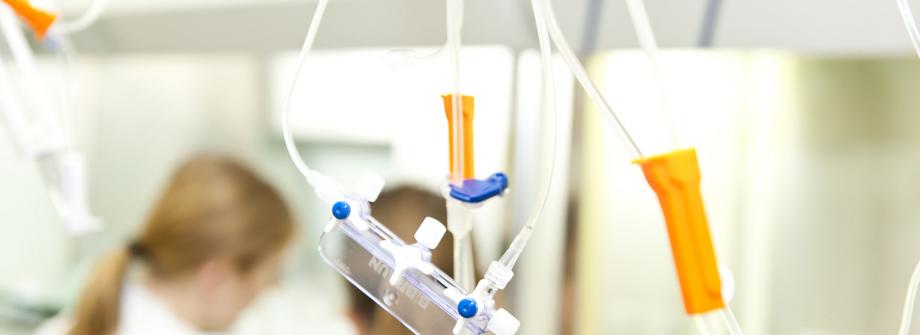
December 2019 Clinical Case of the Month
Title: Long lasting anaemia after reduced intensity allogeneic hematopoietic cell transplantation
Submitted by: Syed Ali Abutalib and Nicolaus Kröger
Physicians expert perspective: Nina Worel
61-year-old female with JAK2 V617F positive primary myelofibrosis (PMF) returns to clinic for urgent evaluation on day+71 following reduced-intensity allogeneic hematopoietic cell transplantation. She reports extreme fatigue and worsening dyspnea over last week. On physical examination, she appears pale, tachypneic with heart rate of 112 beats per minute. The sclera is icteric. Spleen, which was 6 cm prior to transplant is now 2 cm below the costal margin. The donor was HLA-matched sibling, CMV+ and A+. The patient is CMV- and O+. Her medications include tacrolimus, letermovir, acyclovir, dapsone and ursodeoxycholic acid. The neutrophils and platelets engrafted on days +13 and +17, respectively. However, she has become increasingly anemic with hemoglobin levels of 5.8 g/dL compared to pre-transplant levels between 8 to 8.5 g/dL. The white blood count (WBC) and platelets are 3.9 x109/L and 132 x109/L, respectively. The renal function, iron levels and coagulation profile are within normal range. Serum LDH and indirect bilirubin levels are elevated. Haptoglobin and reticulocyte count levels are lower than normal limits. The direct antiglobulin test (DAT) is positive. The quantitative polymerase chain reaction (PCR) for CMV, parvovirus B19, HHV-6 and BK virus are negative. Peripheral blood smear examination demonstrates normal morphology of WBCs, normocytic, normochromic anemia, with few fragmented red blood cells. Bone marrow biopsy demonstrates markedly decreased erythroid precursors with grade +2 fibrosis.
Which of the following is the most likely diagnosis?
- Early relapse of primary myelofibrosis
- Poor graft function due to bone marrow fibrosis
- Hemolytic reaction due to parvovirus B19 infection
- Drug- induced thrombotic microangiopathy (TMA) syndrome
- Noninfectious pure red cell anemia (PRCA)
Expert Perspective by Nina Worel
Educational objective: Recognition of immunologic hemolytic anemia and pure red blood cell aplasia after major ABO incompatible allogeneic hematologic cell transplantation.
Due to the fact that the human leukocyte antigen (HLA) system is inherited independently of the blood group system, approximately 40–50% of allogeneic hematopoietic cell transplants (HCT) are performed across the AB0-blood group barrier.1 Major ABO incompatibility (appr. 20–25% HCT) is characterized by the presence of anti-donor isoagglutinins (e.g. A donor to a O recipient). As isoagglutinin producing plasma cells are terminally differentiated they are relatively resistant to chemo/radiotherapy and can survive the conditioning regimen. The presence of recipient isoagglutinins directed against donor red blood cells (RBC) results in delayed RBC recovery (pure red cell aplasia, PRCA) that may persist for months or years after transplantation. In terms of neutrophil and platelet engraftment the vast majority of studies found no significant influence of ABO match between donor and recipient. PRCA occurs with an incidence of 15–20% after major AB0-incompatible transplantation characterized by reticulocytopenia in the absence of relapse and viral infections. Laboratory signs of hemolysis can be present. The risk of PRCA appears to be higher in recipients of older age, a group A donor, and use of non-myeloablative conditioning regimens.2
In the current clinical case PRCA is most likely due to major ABO mismatched HCT, absence of viral infection, nearly normal white blood cell and platelet counts (choice E is correct). However, elevated LDH and indirect bilirubin levels together with a positive DAT and decreased haptoglobin and reticulocyte counts are also an indicator for hemolysis.
The incidence of PRCA influenced by the degree of suppression of recipient B-cells by the intensity of the conditioning regimen and post-transplant immunomodulation (e.g. rapid withdrawal of immunosuppression, occurrence of GvHD). Stussi et al. compared 2 strategies for hemolysis prevention in major ABO mismatched transplantation and found that pre-transplant plasmapheresis and infusion of donor type RBCs to reduce the titer of anti-donor isoagglutinins before transplantation is associated with a reduced risk of developing PRCA.
In our center we would start with EPO to stimulate erythropoiesis if RBC engraftment is not observed on day +60. This may be effective especially in cases where anti-donor isoagglutinin titers are low. As a next step in non-responders we would initiate plasma exchange which transiently reduces isoagglutinin titers in the peripheral blood. A far more selective strategy for antibody depletion is ABO-specific immunoadsorption. This technique enables highly efficient elimination of ABO antibodies without major losses of essential plasma components. Rituximab would also be an option, however results in profound B-cell depletion exposing the patient to the risk for infections. Last but not least, mechanisms to enhance the graft-vs-host response have been reported to result in clearance of recipient derived B-cells this strategy may result in the development of GvHD that may be more difficult to manage and of higher risk to the patient than continued transfusion support until eventual resolution of anti-donor isoagglutinins.
Correct Answer – E
References
- Rowley SD, Donato ML and Bhattacharyya P; Red blood cell-incompatible allogeneic hematopoietic progenitor cell transplantations. Bone Marrow Transplantation2011; 46: 1167–1185.
- Bolan CD, Leitman SF, Griffith LM, Wesley RA, Procter JL, Stroncek DR et al. Delayed donor red cell chimerism and pure red cell aplasia following major ABO-incompatible nonmyeloablative hematopoietic stem cell transplantation. Blood 2001; 98: 1687–1694.
- Stussi G, Halter J, Bucheli E, Valli PV, Seebach L, Gmur J et al. Prevention of pure red cell aplasia after major or bidirectional ABO blood group incompatible hematopoietic stem cell transplantation by pretransplant reduction of host anti-donor isoagglutinins. Haematologica 2009; 94: 239–248.
Contacts
Syed Ali Abutalib, MD
Associate Director, Hematology and Cellular Therapy Program
Director, Clinical Apheresis Program
Cancer Treatment Centers of America, Zion, Illinois
Associate Professor, Rosalind Franklin University of Medicine and Science
Email: abutalib110@gmail.com
Nicolaus Kröger, MD
Professor and Medical Director of the Department of Stem Cell
Transplantation at the University Hospital Hamburg-Eppendorf, Germany
University Hospital Hamburg, Hamburg, Germany
Correspondence: Nicolaus Kröger, MD
Email: nkroeger@uke.uni-hamburg.de
Expert Perspective
Professor Nina Worel
Medical University of Vienna
Vienna, Austria
nina.worel@meduniwien.ac.at
Future Clinical Case of the Month
If you have a suggestion for future clinical case to feature, please contact Nicolaus Kröger.